How To Do Electrical Box Makeups
How to Crude-In Electrical Wiring
Do-information technology-yourself guide with professional person techniques for a safety wiring task.
![]() Fourth dimension
Fourth dimension
Multiple Days
![]() Complexity
Complexity
Intermediate
![]() Price
Price
$51–100
Introduction
You tin relieve a lot of money past doing your own wiring. Here nosotros'll show you to wire an entire room. Even if you've never picked upwardly an electric tool in your life, y'all tin safely rough-in wiring by post-obit the directions in this article. You'll learn all of the pro techniques for a wiring job, including choosing the right size receptacle boxes, running cable throughout the room, and making the electrical connections.
Tools Required
Plastic boxes and flexible nonmetallic cable (commonly chosen Romex) put electrical wiring projects within the skill range of every dedicated DIYer. In this article, we'll show you some firm wiring basics—how to position outlet and switch boxes and run the electrical cable between them. We won't cover many other business firm wiring details. For help with circuit design and making connections to your main electrical panel, nosotros recommend you consult a licensed electrician.
Besides standard hand tools, you'll demand a special-purpose tool to cut and strip electric wire. We similar the Klein No. 1412 ($18 at hardware stores and home centers). To drill a few holes, use a 3/4-inch spade scrap in your electrical drill. For larger jobs, rent a heavy-duty correct angle drill ($25 per solar day) and equip it with a 3/4-inch x six-inch auger chip ($7).
Electric business firm wiring mistakes tin exist deadly, then make sure you obtain a permit from your local edifice section and accept an electrical rough-in inspection scheduled with a building official when yous're finished. Draw a sketch of your room that shows lighting, switch and outlet locations. Review your plan with the inspector and ask whether at that place are any special requirements.
Be safe! Here are the tiptop electrical mistakes to avert:
Project stride-past-step (13)
Step 1
Marker the Box Locations
- Mensurate and mark the eye of each box.
- Mark the height from the flooring to the center of the boxes (unremarkably 48 in. for switches and 12 in. for outlets) or line them upwards with existing boxes to determine electrical outlet top.
- Use letters and symbols to place boxes.
- Add 2x4 blocks to position boxes away from broad window and door trim.
Step 2
Mark Box Location with These Symbols
- Marking the box locations on the studs using symbols to indicate outlets, switches and lights.
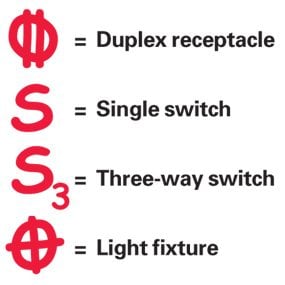
Footstep 3
Place the Box on the Framing Member
- Position the box and then its face will be flush with the wall covering cloth.
- Nail the box to the framing.
- Pro tip: Double-bank check that the confront of the box is parallel with the framing fellow member.

Step 4
Calculating Box Sizes
The electric code limits how many wires y'all can safely put in an electrical box. To figure the minimum box size required by the National Electrical Lawmaking, add:
1 – for each hot and neutral wire inbound the box
i – for all the basis wires combined
1 – for all the cable clamps combined (if any)
two – for each device (switch or outlet-just not light fixtures)
Multiply the total by 2 for 14-gauge wire and 2.25 for 12-approximate wire to get the minimum box size required in cubic inches. Plastic boxes have their volume stamped inside. Steel box capacities are listed in the electrical code.
Nigh boxes take nibs or marks to help you lot marshal the box for use with standard 1/2-in. thick drywall. If you're not certain how thick the final wall material will exist, employ a special adaptable depth box.

Drill Holes in the Framing
- Bore iii/4-inch holes through the framing members about viii inches above the boxes.
- Pro tip: Center the bit on the stud, brace the drill and apply force per unit area with your thigh for easier drilling of wall studs.
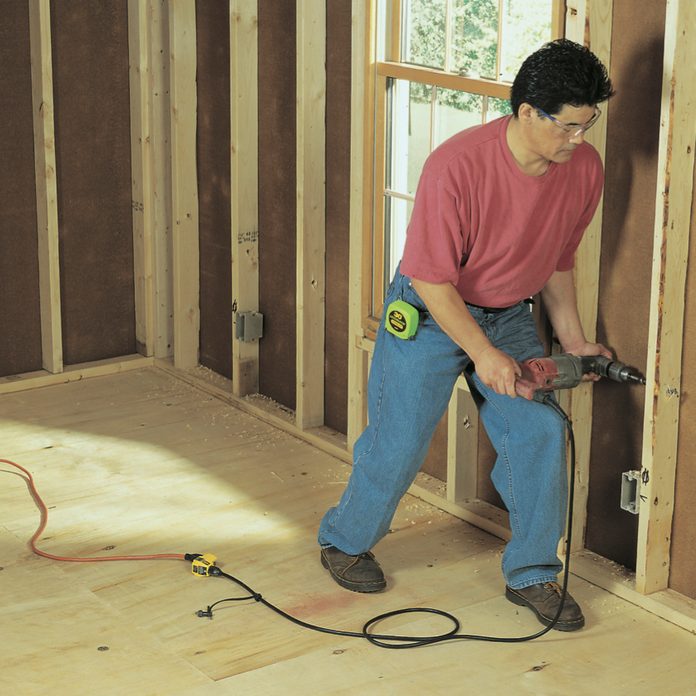
Step 5
Drill into Corners at an Angle
- Bending the bit into tight spots.
- Make sure at that place's at least one-1/iv inches between the back face up of the stud and the cable.
- Cover the confront of the stud with a metal nail plate to protect the cable where the hole is closer than one-1/four inches to the confront of the stud.

Pace half dozen
Thread the Cable Through the Holes
- Straighten about 12 feet of cablevision and thread it through the holes from one box to the next.
- When y'all reach each new box, follow the stripping procedure shown below, and push the conductors and about 1/4 inch of sheathed cable into the box.
- Staple the cablevision.
- Cutting the stop yet continued to the roll and repeat the process at the other box.
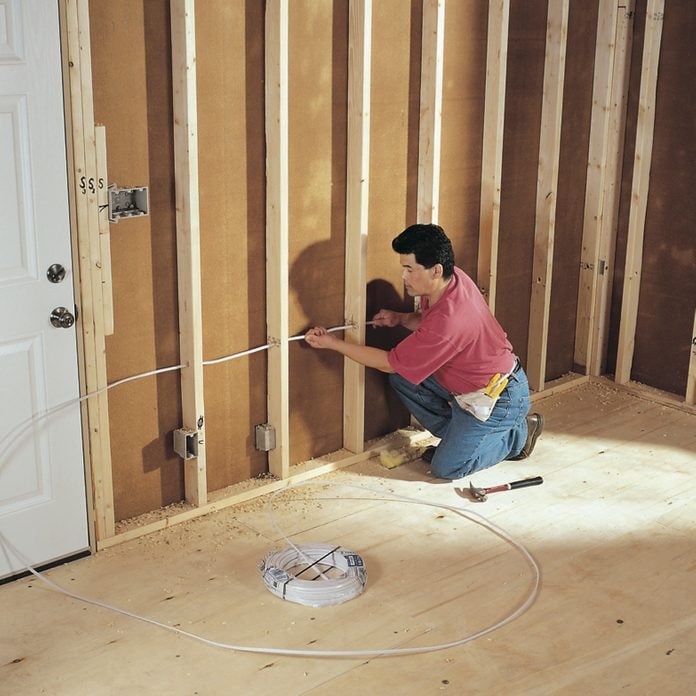
Step 7
Run the Cable Around Corners
- Fish the cable effectually corners by bending a sharp hook in it.
- Stick your pinkie into the pigsty to feel for the cable and guide it through as y'all use pressure with the other paw.
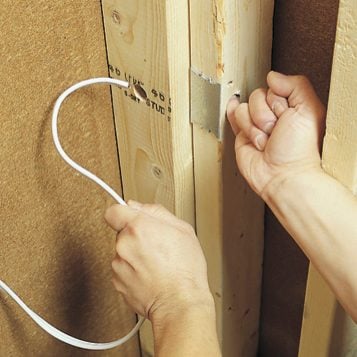
Step 8
Cutting the Cablevision at the Box
- Grab the cable at the point you gauge it will enter the box.
- Cut the cablevision near 12 inches beyond this spot and strip off all simply about 1 inch of sheathing.

Step 9
Knock Out a Hole in the Box
- Punch a hole (or two for ii cables) through the knockout expanse of the box with a screwdriver or the point on your stripping tool.
- Push the conductors and about ane/4 inch of sheathed cable into the box and staple the cable within 8 inches of the box.
- Note: The cable must be at least i-1/four inch from the face of the framing.
- Push the kickoff cable aside while yous staple the second cable.

Footstep 10
Run Cables to the Main Service Panel
- Run cable(s) from your completed circuits to the service panel.
- Pro tip: Go out 4 extra feet of cable for the electrician to work with.
- Label the cables with the location of the excursion.
- Phone call in the electrician to connect the circuits.

Step 11
Cut and Strip the Wires
- Cut all the wires to leave at least 6 inches protruding past the face up of the box.
- Leave one bare copper ground wire an actress half dozen inches long.
- Thread the long basis wire through the pigsty in the top of the special green wire connector and splice all the footing wires past holding them together and twisting the connector clockwise until information technology's tight.
- Strip the ends of the white and blackness wires and one end of each half dozen-inch-long pigtail.
- Splice them with wire connectors.
- Cover the unstripped terminate of the black (hot) pigtail with a wire connector for condom.

Step 12
Grouping the Wires Together
- Grouping and label the wires in the switch boxes then you'll know how to connect them afterward the drywall is complete.
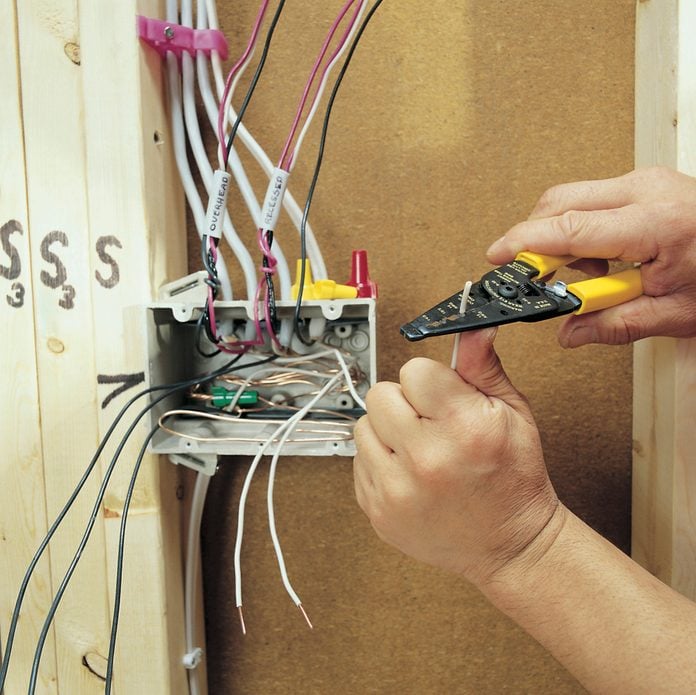
Step thirteen
Push button the Wires into the Box
- Fold and pack the wires neatly into the box to conserve space and reduce pressure on connections.
- Characterization wires with scraps of cable sheathing.
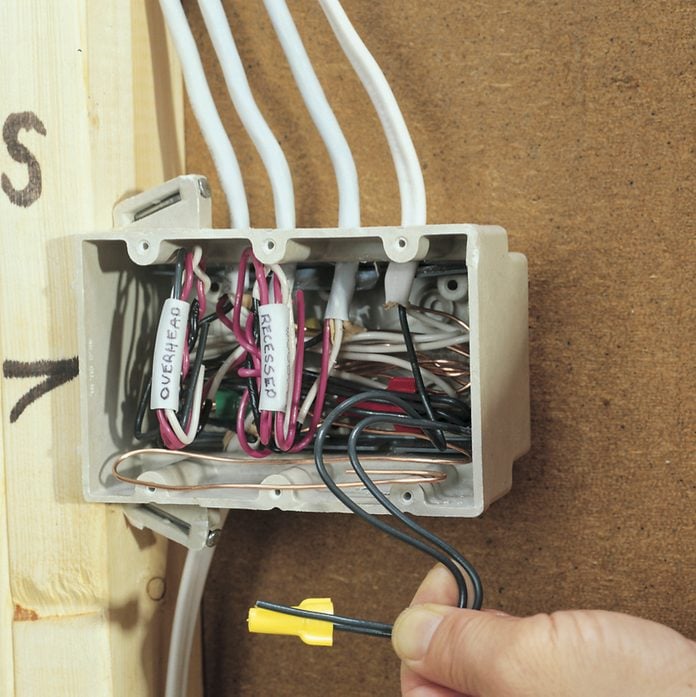
Originally Published: September 22, 2020
Source: https://www.familyhandyman.com/project/how-to-roughin-electrical-wiring/
Posted by: cattplithenewark.blogspot.com

0 Response to "How To Do Electrical Box Makeups"
Post a Comment